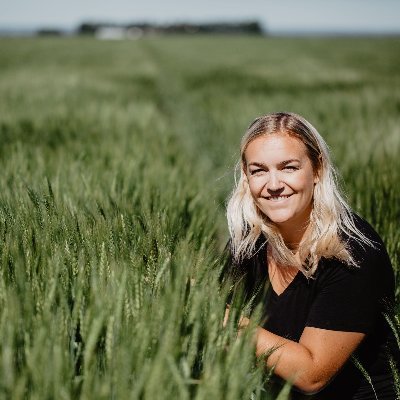 Mallorie Lewarne works as an Agronomy Extension Specialist for cereal crops with Manitoba Crop Alliance.
Mallorie Lewarne works as an Agronomy Extension Specialist for cereal crops with Manitoba Crop Alliance.
Agronomists are experts in the science of soil management and crop production, so Mallorie gets to do all sorts of exciting work in the field while researching the latest innovation trends to ensure cereal crops in our province like wheat and barley grow strong and feed as many people as possible!
We asked Mallorie about her job and why she thinks agriculture education is important.
Tell us what you do!
My role here involves developing extension materials with the latest agronomy-based information, event planning, and representing MCA on external committees.
How does the work of an agronomy specialist impact the every day lives of students?
I think it’s important for students to know that there are so many opportunities in the agriculture field! I feel lucky that my role allows me to stay involved in research while also getting to engage with Manitoba farmers.
What else would you like Manitoba students to understand about the work you do?
Another interesting part about my role is that I get to help review research proposals. MCA is contributing to sustainability by funding research programs that are looking at innovative production practices on a whole-farm scale — so things like nutrient use efficiency, soil health, managing extremes of moisture, as well as pest management.
Tell us about your experience volunteering for AITC-M!
I’ve volunteered with Agriculture in the Classroom-Manitoba a couple times now and I always leave the classrooms feeling excited that students are so willing to learn and Ag in the Classroom also provides resources for the classroom that are so easy to use and help you tell your agriculture story in a way that allows you to personalize it.
Why is agriculture education important to you?
I think ag education is important to reconnect the producer and the consumer. I hope that continual ag education in our schools will promote informed decision-making and the ability to look past marketing schemes. I think ag education is important in making sure students know just how many career opportunities are available to them within the industry.
What excites you most about the future of agriculture?
I’m excited to see continued collaboration and innovation. Agriculture exists to meet our basic needs while facing extremely complex problems, so it’s exciting to see various parts of the value chain come together with unique, new ideas to solve these issues.
Questions from the Classroom, Answers from the Expert
How long does it take for wheat and barley to turn into cereal? – Grade 3 & 4 classroom
The growing season for wheat and barley is typically about four months in length. Seeding occurs in late April to early May in Manitoba, and harvest typically begins in August. From there farmers can choose to either sell their grain right off the combine or store it and sell it later. Once the grain moves through the grain handling system, it can be purchased by a milling company – where the milling process begins. The grain first goes through a “sweating” process which takes around 6 weeks. From there it goes through quality control, tempering, milling, and sifting processes. The flour and by products can then be ready to be used in a variety of food products – a typical cereal purchased at the grocery store can be produced using an extruder in around 24 hours.
Why do farmers need to plant forage crops regularly? – Grade 7 & 8 classroom
Including forage crops in a crop rotation can have many benefits including – improved soil health, increased organic matter of the soil, better water infiltration and drainage, reduced tillage in subsequent crops, less root disease, reduced salinity, and less soil erosion. What is the difference between silage and a bale? Both silage and hay bales are popular ways for farmers to feed their livestock when they are unable to graze. Both are considered a preservation method for forage crops. They differ in moisture content, storage methods, and digestive capabilities.
Do cows and horses eat hay or straw?
Primarily hay, but straw can be fed to livestock if properly supplemented. Straw does not provide enough energy and protein to meet an animal’s nutritional requirements and is sometimes used to stretch a hay supply to get through the winter.
Watch a clip of Mallorie's interview on our Instagram page >>